Partnering up for tactical town planning is what’s going down in Stonemaier Games’ fun, fast playing tile layer, Between Two Cities!
Publisher: Stonemaier Games
Designer: Matthew O’Malley, Ben Rosset
Solo Designer: Morten Monrad Pederson
Artist: Beth Sobel
Release date: 2015
3-7 Players (2 player and solo mode variants)
Age: 14+
25 mins
Favouritefoe score: 8/10
* Tile Laying * Spatial Puzzle * Semi-Co-operative * Communication * Competitive * Two Player * Multi Player * Solo Mode * Automa Factory * Close Drafting * Tableau Building * Set Collection * Pick and Pass * Fun * Family *
In my mind, whenever I think of Stonemaier Games, my eyes sparkle and my brain goes immediately to (a) top quality, beautiful components (b) Automa Factory flipping awesomeness and (c) fun and satisfying game play.
I don’t often consider player count because their games have always suited however many (or few) people around my table. And given that it is usually one or two (including yours truly) on an average weeknight, it’s not an unmanageable number to accommodate. So when I opened the box and saw “3-7 Players”, I was a little surprised. Had I looked a fraction of a second longer, however, I would have seen the additional words “1-2 player variants”. Instant panic over!
So, with that settled, we cracked into Between Two Cities and I’m now here to tell you the tale of two (and more) cities!
19th Century Construction!
Between Two Cities is a tile laying game set in the early 1800s. In it, we are playing famous master city planners, each tasked with re-designing two cities. Every tile falls into one of six categories of building/space. But cities are big projects, and going it alone would be a massive task. So we are pairing up with other professionals with whom we can discuss ideas and innovate – one for the city on our left and one for the city on our right.
In a tile-laying town planning twist, however, this is not a strictly co-operative game. At the end of it, there can be only one winner. And, obviously, that is whomever has the highest scoring city. But, in another strategic switch-up, only the lowest scoring city we have each worked on is going to count in the final tally!
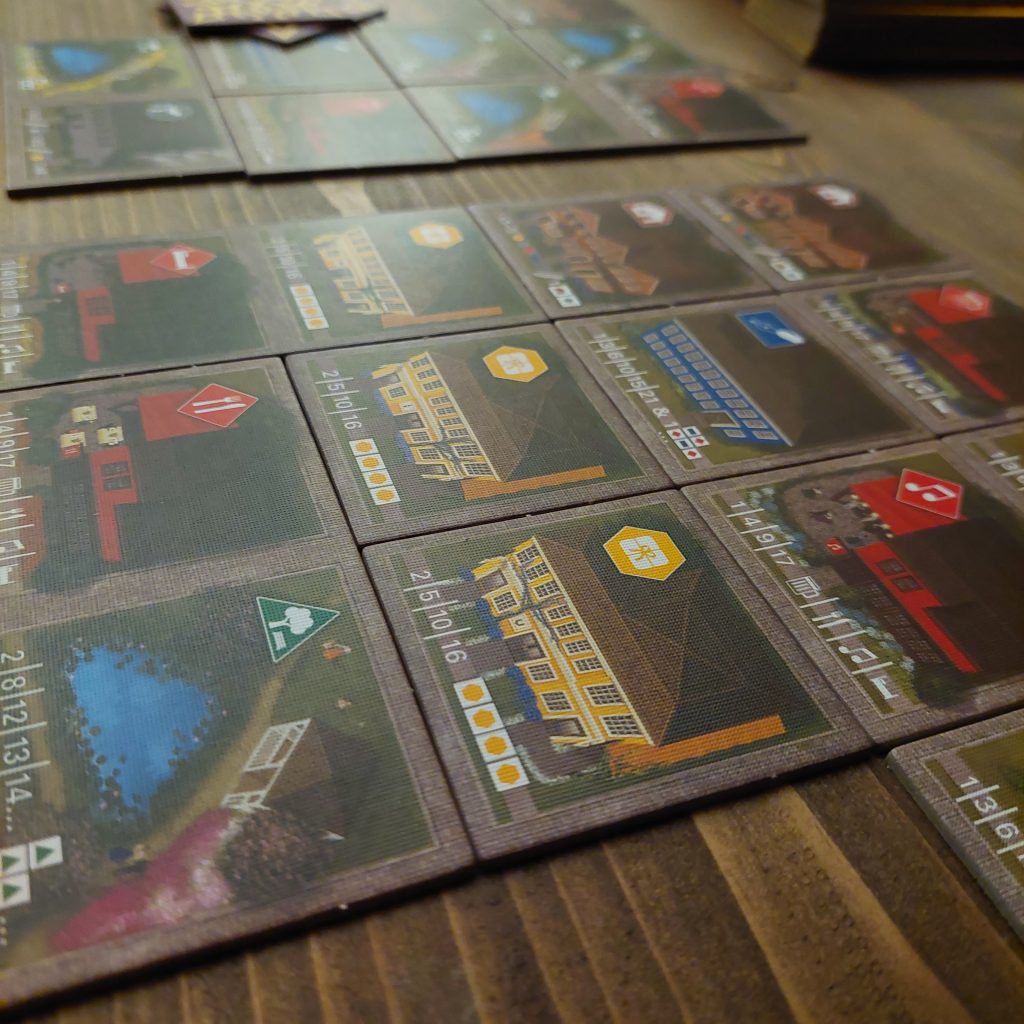
Plotting and Playing!
Setting up Between Two Cities is a synch. It’s basically shuffle the single (108) and double (24) building tiles, stack them into piles and then lay out the HUGE score board somewhere close by. Each player gets a starting hand of 7 single tiles and a scoring token per city (the other matching token goes on the score board for end game points totalling). And that’s it. Time to build!
Played over 3 rounds, in the first round, you’ll have your starting hand of 7 single tiles. In a simple close drafting pick and pass exercise, you’ll secretly (and individually) pick two tiles and pass the remaining tiles to your left. When everybody has done this, you reveal both tiles and place one in each of your cities.
You’ll want to discuss placement with each of your co-builders first though, as the tiles you each place could work for or against you (see scoring below!). And once placed, tiles cannot be moved! This is repeated until players only have 1 tile left (which then gets discarded in readiness for the next round).
In round two, you pick 3 duplex (double) tiles and choose one for each of your cities. Again, for optimal placement purposes, you are going to want to place with the blessing of your professional partner!
The final round is a repeat of the first, but this time the tiles pass to your right. At the end of the game, you will have a 4 x 4 grid of 16 buildings. And then it is time to score each city!
Don’t forget, your final score is the value of your lowest scoring city. And whoever has the highest lowest score (!) is the winner!

City Scoring!
As mentioned above, there are six categories of buildings and each score differently based on their own criteria:
Shops (yellow tiles) score incrementally when connected in a row or column: 2/5/10/16 points depending on how many shops are in a straight line (note that each shop only scores once!)
Factories (grey tiles) score based on how many you have in each city, so the more you have, the more each are worth (but note impact on Houses – below). The city with the most factories gets 4 points per factory, then second most gets 3 points per factory, and all other cities get 2 points per factory.
Taverns (red tiles) score higher the more types of tavern you have in your city (1/4/9/17). If you can collect all four tavern types, that is worth a whopping 17 points! And you can collect more than one set in a single city (but each tavern will only count towards one set).
Offices (blue tiles) score incrementally (1/3/6/10/15/21) but can be anywhere in your city and do not have to be connected to each other. Note that if you can place an office next to a tavern, that office also earns a bonus point!
Parks (green tiles) score incrementally when connected together (2/8/12/13/14)
Houses (brown tile) score 1 point for each other building type in your city (excluding houses). But if you place a house next to a factory (grey tile), it will only ever be worth 1 point even if the other houses are worth 2/3/4/5 points each.
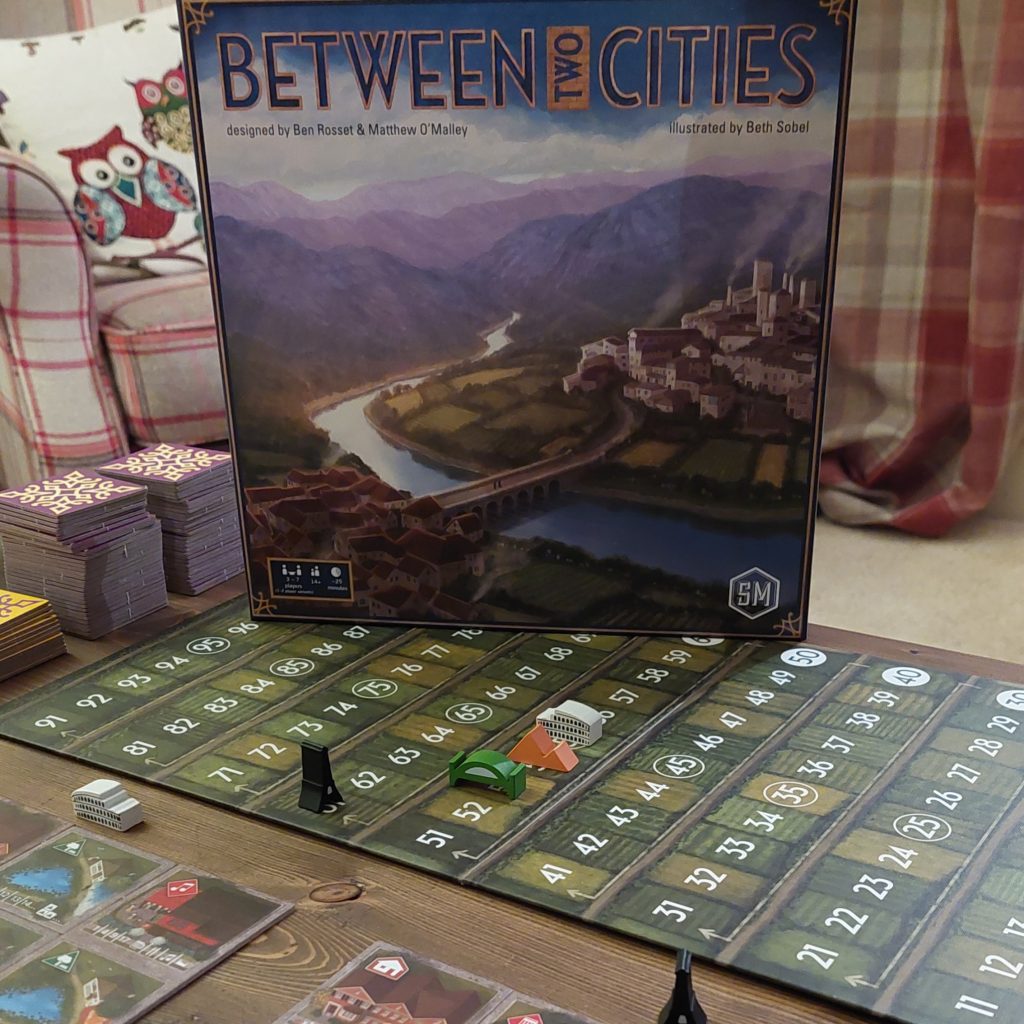
Multiplayer Metropolis!
We love tile laying games.
We love close drafting.
We love spatial puzzles.
We love games that are quick and easy to pick up and play but still have some strategic saltiness.
And Between Two Cities ticks all those boxes.
First game was on the table in seconds. And with the benefit of the easy to understand scoring descriptions and examples in the rule book, it felt like a full game. Not a walk through. Not a talk through (although there was a lot of whispered murmurings going on!). But a real game. And given that one of our 4 players was a non-gamer, the way they easily picked up the objective and were able to take advantage of the partnership mechanism shows the accessibility and uniqueness of Between Two Cities.
I have played co-operative games and semi-co-operative games before. But they are usually more complicated role play, social deduction based games. In contrast, Between Two Cities takes the conflicted work together/succeed alone dynamic and distils it into a fast playing, tile laying, family friendly game that works really well! It is ultimately a game of tile laying trade-offs. And each placement feels significant. Every decision you make will impact upon the remainder, in either a good way or a bad way.
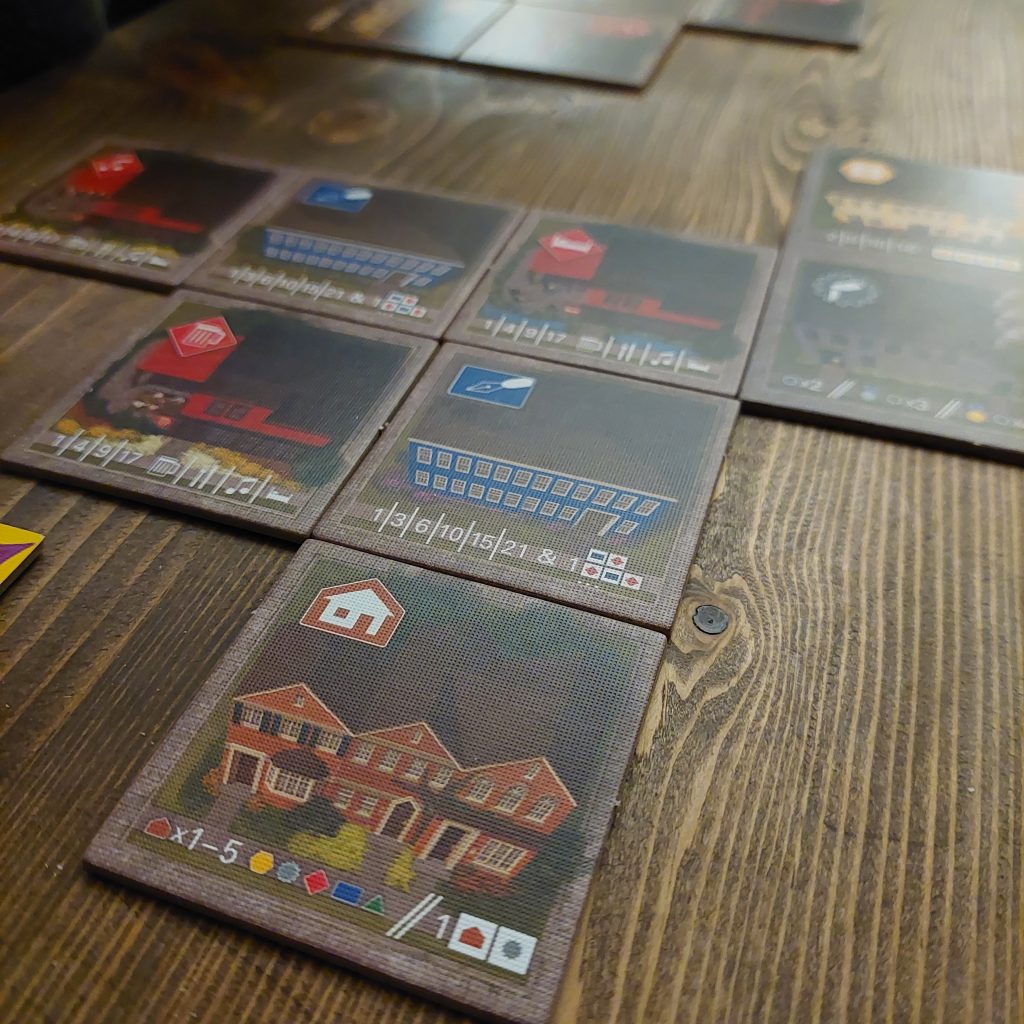
But, unlike a lot of games where you have to pick a strategy and run with it, Between Two Cities offers a little wriggle room to change tack if the luck of the draw isn’t going your way. As the building categories score at least some points even at lower numbers, it is possible to accumulate them in smaller chunks, or change what you are collecting as the game progresses. You may not win, but you won’t feel like you didn’t achieve something either.
Between Two Cities is not just a straightforward pick, pass, and place. Because each building categories scores differently, there are competing interests and spots you gun for in order to achieve maximum point optimisation.
Indeed, if you look at Parks; they start off strong – each additional connected tile increases the value of the green zone. But, once you hit 4, choosing to add another Park tile to the group (rather than selecting a different tile from your hand or even starting a new green zone) has less value.
Likewise with Factories. You might want a lot of these to maximise the score per grey tile in your city. But any Houses you then have could be worth significantly less as nobody wants to live next to a factory! And that is before you even consider what your partner is planning or has in their hand!

Partnering up also has another bonus. The simultaneous action phase in this game definitely reduces downtime between turns (and helps minimise my analysis paralysis as there is someone to push the button when I go on pause). When you add more players, games don’t seem to take that much longer because everyone is carrying out phase 2 at the same time. But, when there is a delay, (mostly because you need to have one eye on what your opponents are doing, one eye on what you want, as well as one ear listening to your partner) there’s always something to consider whilst waiting for others to finish placing their tiles. After all, you can’t discuss what tiles you are each going to pick during the drafting phase. And you won’t know what is coming back your way in terms of building options. So you need to plan ahead with your fellow professionals as much as you can! And if you and your partner each want you to place a different tile in the city you share…….well, it’s building bargaining time! Your duplex tiles can also be horizontal or vertical so really you have to leave enough space for either situation prior to the round(s) in which they arise.
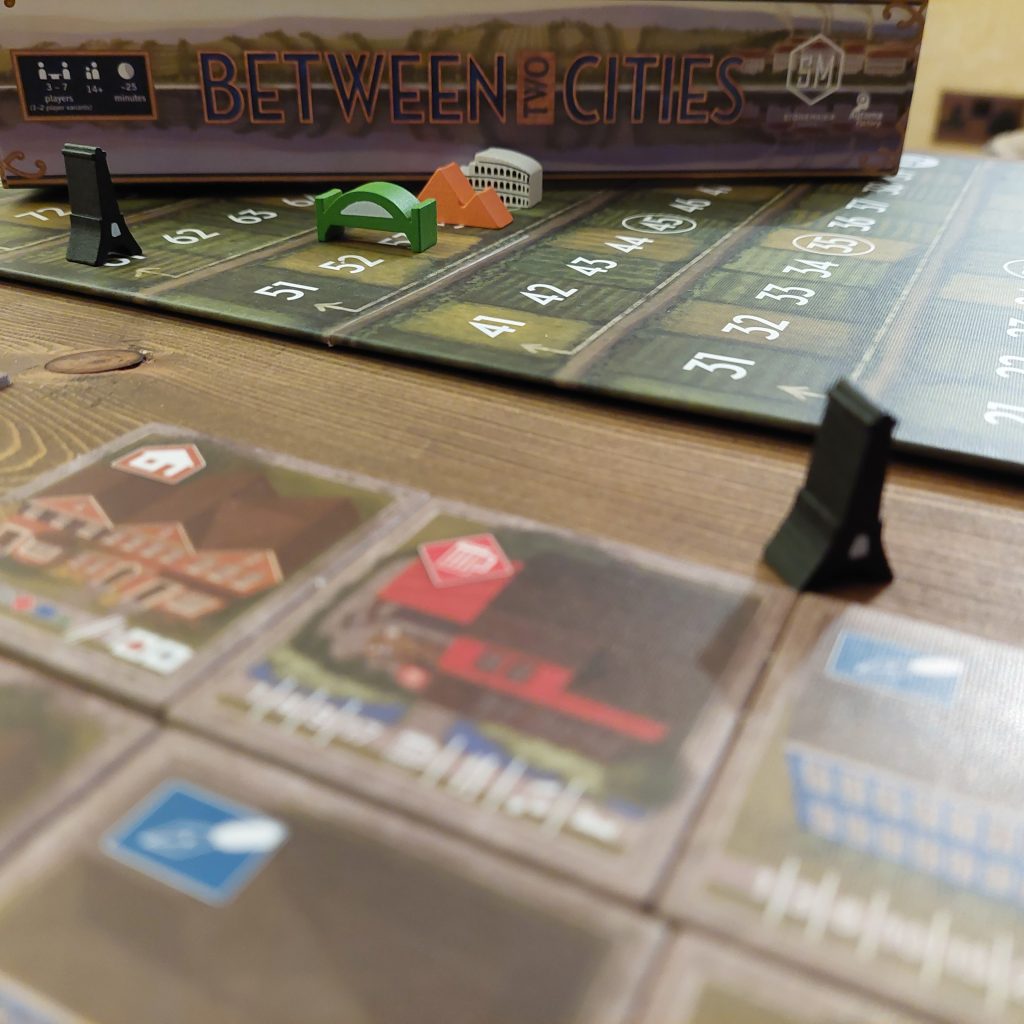
Two Player Town Off!
I was super relieved when I saw the 1-2 player variant note on the box as a lot of our core gaming is done a deux. And having played it, the variant works really well with very few changes. It is a very different game when playing at 2, however. It is pure competition. It is 2 cities v 2 cities and we loved it!! You see, behind the undying love and devotion and friendship of our marriage is a wave of fierce gaming competitiveness. And any chance we get, we hate draft each other into carboard oblivion! Haha.
Same 7 tile starting hand in round 1. Same pick and place into two different cities. But this time, there are 6 rounds in total (using single and duplex tiles) and both cities are yours and yours alone. Oh and this time, the winner is the player with the highest combined score from both!
Our two player games of Between Two Cities go quickly. Focussing on what we need ourselves often comes secondary to what we don’t want the other to collect. The close drafting feels a lot more personal because anything you pass along is likely to end up in the cities directly opposite you and you only have yourself to blame for that!
At two, the competitive side of Between Two Cities works superbly as a bright and breezy, fast playing, double duel. I think the designer’s decision to change the gaming style to suit was the right one. And I don’t think it would work as well as a co-operative at such a low player count because there’s not really enough depth to keep two players pondering for long. But that’s fine because you can adapt the full solo mode (see below) to add an additional third player into the mix if you do prefer to avoid direct conflict in the game. And I don’t think it is intended to be a saga length experience. Indeed the <25 minute play time is perfect for us when we want a thinky filler that can be played and packed away leaving room for another game (or life’s colourful chaos!). Well, I say that, but so far at the end of one game, we have each wanted to better our performances, and so one game is evidently never enough for us!
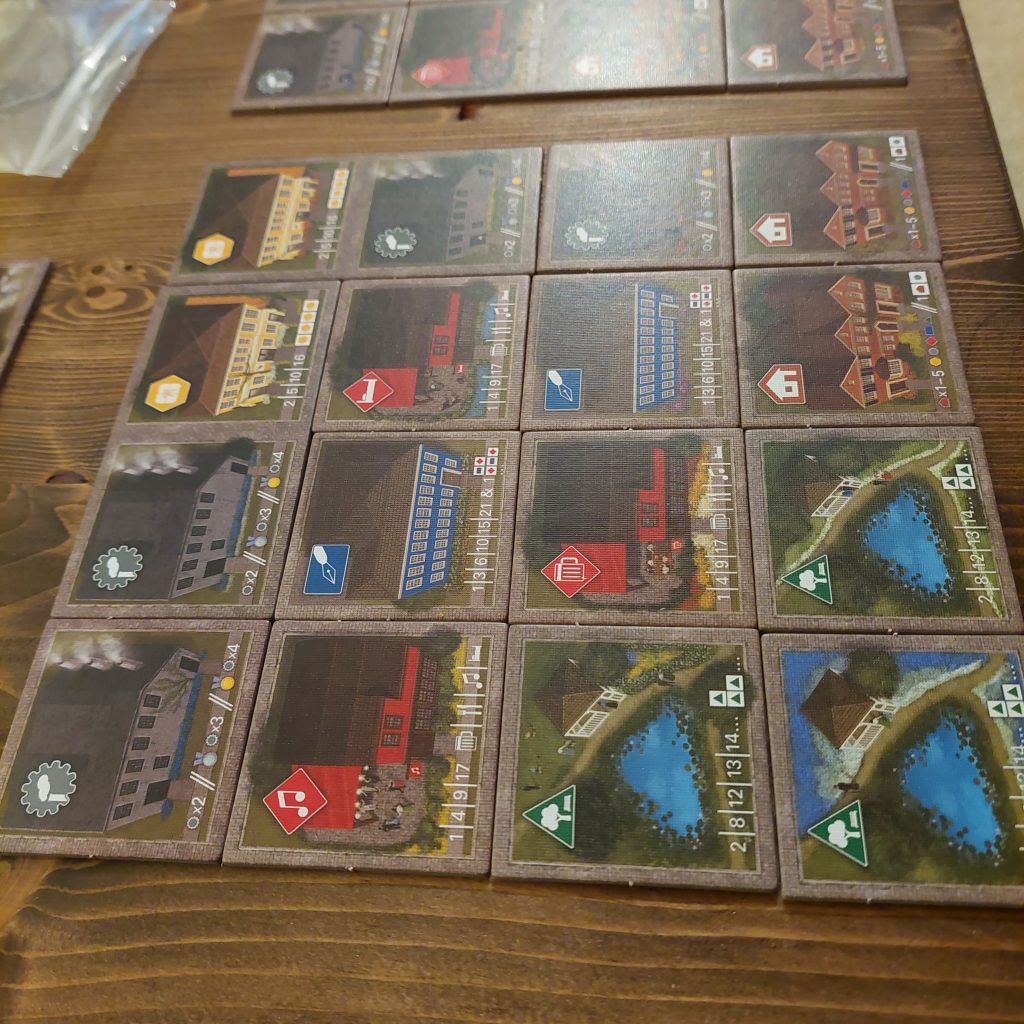
Automa Factories
Interestingly, Between Two Cities contains two different solo play experiences. There’s a simpler one where you build a city and “Automacity” picks whatever scores “maximally” – decided simply by looking at how many of each category type it is amassing with no need to place tiles out in a grid. They also have some extra bonus scoring situations, so its office tiles score bonuses by simply having 1 tavern and its houses are never discounted by factories (which makes sense as you aren’t technically placing the tiles out). This version requires you to have your maths hat on, but isn’t too tricky as you should already be on the lookout for what scores best!
The other “full” automa mimics a 3 player game using two bots “Authomasso” and “Automarta” which are managed via a special deck of cards. In each case, the automas’ choices are prescribed, and their actions follow a priority order. This means minimal thinking time on your part, but you do a little bit of insider information which might influence your own picks which wouldn’t happen in a normal 3 player game between human players. As a bonus, you can also incorporate 2 players into the solo mode to create a less head-to-head gaming experience.
I have only tried the simple mode so far, and it was a quick, solo puzzle which I enjoyed. As one of my priorities in solo gaming is quick set up, this definitely meets that requirement.
Quality Componentville!
Perhaps not technically a game component, but the rule book is superb. Okay, so it isn’t a complicated game, but the scoring does require some understanding. And the rules with the final layout examples couldn’t be clearer. It is probably one of the few rule books today where we have looked through it and had no need to flip back and forth, settling simply upon the scoring criteria page for reference at end game. And not that you’ll need it, but the back page has a handy round summary if you do forget what comes next!
The wooden building tokens and the tiles themselves are lovely – thick, chunky, and built to last. The tiles themselves also helpfully have their scoring criteria neatly summarised on each (using numbers and symbols), and interesting little artistic details that are unique to every one. I didn’t notice this at first, but look loosely and you’ll see it (a lot like Kingdomino, Dice City etc.). Whilst Beth Sobel’s colour palette may be slightly muted in Between Two Cities, her attention to detail never wavers. The score board is also incredibly sturdy and surprisingly HUGE. Like MASSIVE. I mean it’s great not to have to squeeze tokens on a tiny space, and its top quality. But it could have easily been half the size with no problems!
We are having a great time with Between Two Cities. It is a game we can pull off the shelf when we want a simple, fast playing, spatial duel, or one to play when we have a bigger/mixed group coming round the table. I really like the dynamic between working together and succeeding alone, as well as the straight up two player competition. As we play it more, I’d really like to try it with the expansion Between Two Cities: Capitals as I think bringing new elements and extra tactical trade offs could elevate the game beyond a thinky filler to a main event gaming experience. Have you played Capitals? Shout me an email as I’d love to know what you think of it!
[Please note that a copy of this game was kindly provided by the publishers for review. I am not paid for my comments, however, and all opinions are my own]. I am also not affiliated to or sponsored by any retail store.

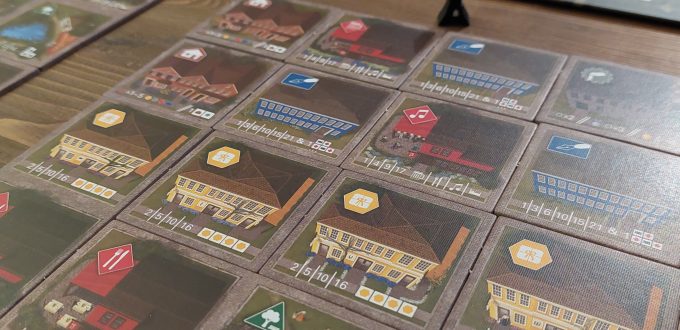
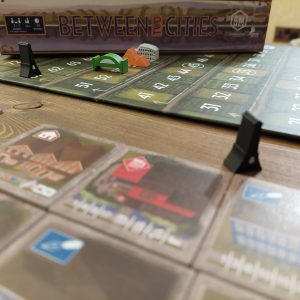
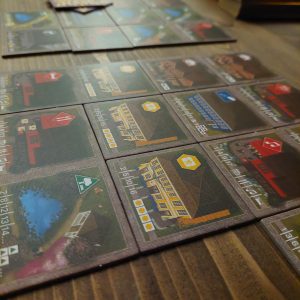



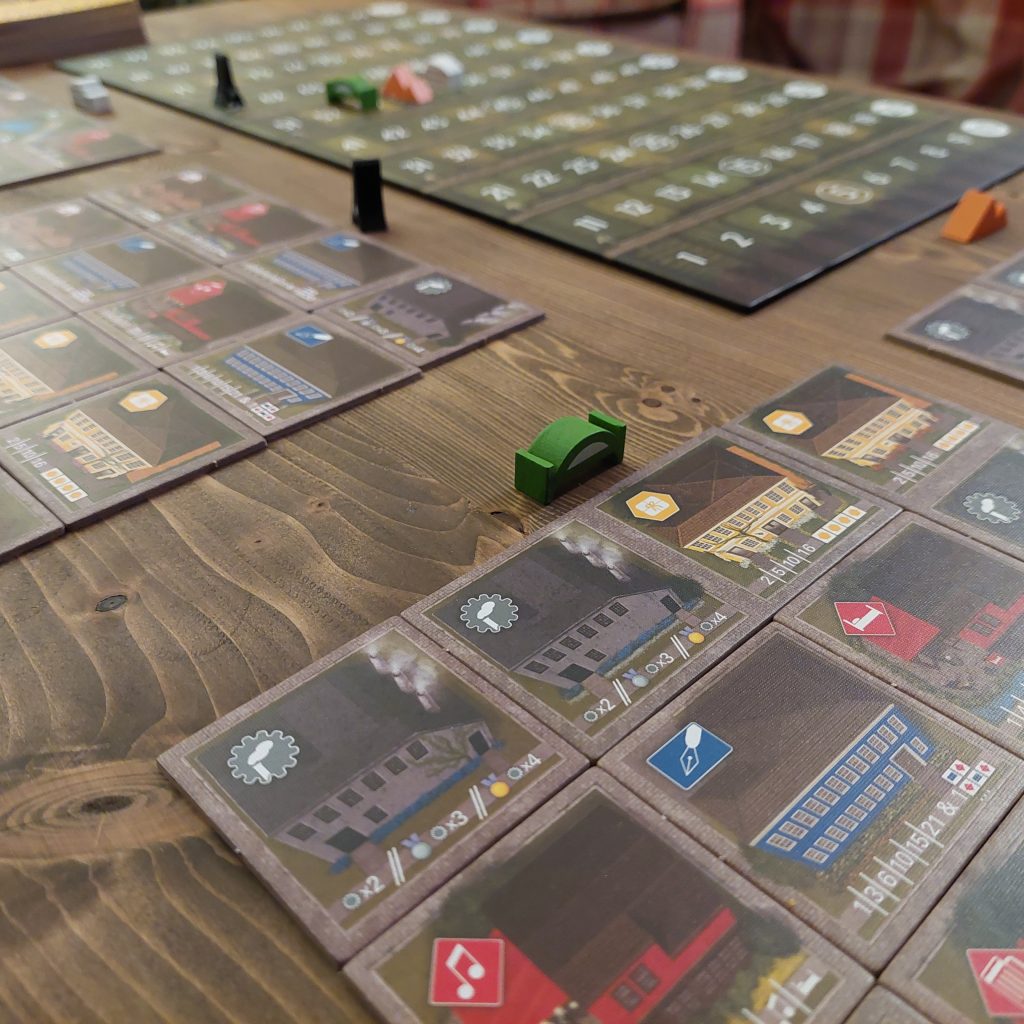
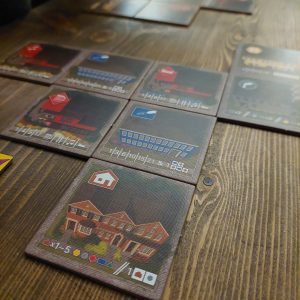
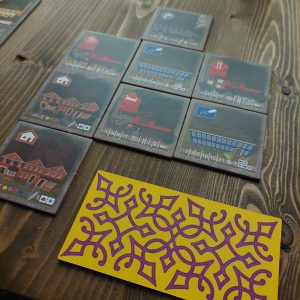

[…] risk repeating myself – you can find all the core details and how to play Between Two Cities here. What I’ll focus on in this review is the Essential content and how it changes the basic game […]